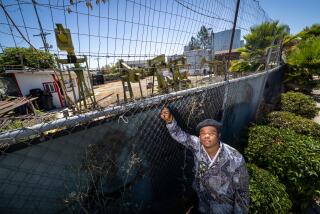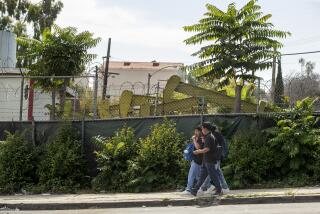Op-Ed: California’s appearance at the climate change talks belies an L.A. oil and gas health threat
- Share via
Gov. Jerry Brown and a delegation of California officials are in attendance at the U.N. climate change conference in Paris. They are there, in part, to tout the state’s efforts to cut carbon pollution and simultaneously grow the economy. Yet as much as California’s environmental progress deserves recognition, it is hardly sufficient, and that is especially true at the local level.
Yes, California’s system for measuring air quality is more stringent than the national standard, but it doesn’t save us from breathing the dirtiest air in the country. Our clean energy goals are ambitious, and yet California remains one of the top oil-producing states in the nation — often drilling in the backyards of our state’s poorest and most vulnerable residents. And while the state-mandated cap-and-trade program puts a price on carbon in order to reduce it, that does little to cut pollution in areas where power plants and refineries are housed.
California lacks the political will to ... protect hundreds of thousands of its citizens from the dangerous and exploitative practices of oil and gas companies.
The reality is that California lacks the political will to establish and fully implement regulations that could protect hundreds of thousands of its citizens from the dangerous and exploitative practices of oil and gas companies. There is a real disparity between the environmental dangers faced by low-income communities of color and their more privileged white neighbors.
I serve as senior pastor at the Holman United Methodist Church in South L.A.’s West Adams district. My neighborhood is tightly packed with historic homes, apartments, housing for seniors, a convalescent home and a home for nuns. Children ride their bikes and play basketball in a parking lot near the church. Several schools are located just a few blocks away. Only a wall and a plot of asphalt separate homes in the neighborhood from some 30 active oil wells at the Murphy drill site, operated by Freeport-McMoRan Inc. Oil company workers stand on one side of that wall, dressed head to toe in protective gear and masks, while kids live and play on the other, unprotected and complaining of headaches, nosebleeds and asthma.
These issues are not unique to West Adams — just ask the residents of Porter Ranch, forced out of their homes because of an uncontrollable methane leak at a Southern California Gas Co. facility. But the worst situations are in the poorest communities.
In University Park, a neighborhood only a couple of miles away from my church, a drilling site run by the Allenco Energy Co. was shut down because of community pressure but only after two federal investigators fell ill with nausea and headaches after visiting the site. The Environmental Protection Agency found that the oil company was not taking required precautions to shield the surrounding area from pollutants.
Living less than a half-mile from active oil extraction is considered unsafe, yet a report by Community Health Councils found that 580,000 Angelenos live within just a quarter of a mile — a mere 1,320 feet — from an active well. The state’s own scientists have raised alarms about the risks. Nearly six months ago, the California Council on Science and Technology released a report on the dangers of oil operations in dense urban settings. Among other things, it recommended mandatory setbacks around oil wells to minimize human exposure to toxins. Despite the documented threat and the technology council’s recommendation, Los Angeles’ elected officials have yet to establish a human health and safety buffer to shield homes, schools and hospitals from oil extraction.
In November, a lawsuit was filed against Los Angeles claiming that city officials rubber-stamp oil drilling permits despite state laws that require environmental review. The plaintiffs — many of whom are young people who live near oil and gas sites — allege that the problem is particularly acute in low-income neighborhoods. The suit also contends that extraction is allowed in South Los Angeles and Wilmington with fewer protections and restrictions than at sites in West L.A. and the Wilshire area.
At the Paris climate conference, California may well look like a world leader on environmental solutions. But here at home, thousands of families that live close to drilling sites in Los Angeles are still exposed to severe health and safety dangers. If the state and the city continue to let oil companies drill and extract oil next to schools, homes and hospitals, no matter what Jerry Brown says in Paris, our environmental battles are far from won.
Kelvin Sauls is the senior pastor of the Holman United Methodist Church. He is a member of Californians Against Fracking and a founding member of STAND-LA (Stand Together Against Neighborhood Drilling).
Follow the Opinion section on Twitter @latimesopinion and Facebook
More to Read
A cure for the common opinion
Get thought-provoking perspectives with our weekly newsletter.
You may occasionally receive promotional content from the Los Angeles Times.










